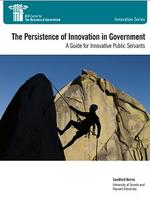
The Persistence of Innovation in Government: A Guide for Innovative Public Servants

With this report, Professor Borins continues two decades of research analyzing winners of and applicants to the Harvard University Kennedy School’s Innovations in American Government Awards. This report presents a comparison of the applications received by the program in the 1990s (1990 to 1994) with those received in 2010. In 2001, the IBM Center for The Business of Government published The Challenge of Innovating in Government, Professor Borins’ report on his 1990s research on innovation.
Professor Borins has found that innovation is alive and well and persisting at all levels of government in the United States, with both shifts and continuities from the 1990s to 2010. One of the most significant findings by Professor Borins is the increasing proportion of innovation initiatives involving collaboration. In 2010, 65 percent of the innovation applicants reported external collaboration as a project component—more than double the 28 percent reported in the 1990s. Nearly 60 percent of the applicants also reported collaboration within government. Significantly, award semifinalists in 2010 reported an even higher incidence of collaboration, with over 80 percent of the semifinalists reporting external collaboration and collaboration within government.
The important trend toward external collaboration and collaboration within government has also been reflected in the increased number of IBM Center reports focusing on “collaborating across boundaries.” In 2013, the IBM Center published seven reports on collaboration, including Implementing Cross-Agency Collaboration: A Guide for Federal Managers, by Jane Fountain; and Collaboration Between Government and Outreach Organizations: A Case Study of the Department of Veterans Affairs, by Lael Keiser and Susan Miller.
Professor Borins concludes his report—which is a companion to his book, The Persistence of Innovation in Government, published concurrently by Brookings—by emphasizing the importance of partnerships among awards programs, academics, and practitioners as key to spurring future innovations. Moreover, the report calls for continued research on innovation in government. Professor Borins argues that it is crucial to understand trends in innovation more deeply and to identify jurisdictions or organizations that support and encourage multiple innovations over time. We strongly support this call for more research on innovation.



